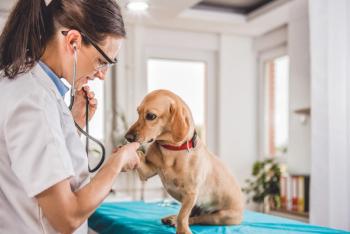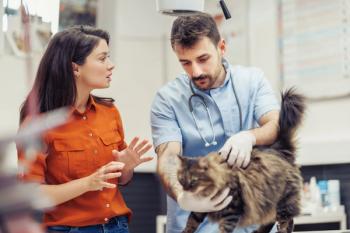
How ignoring a pet in the veterinary exam room can help you
Change your approach and lessen the anxiety your patients feel.
My partner and mentor, Dr. Bill Strobel, taught me to greet pets by both name and touch and then ask the pet for permission to introduce myself to his family. I thought it was a warm and clever way to show genuine affection for the pet, to use the animal's correct name and gender and treat the patient like an important individual, not just one of many.
GETTYIMAGES/MARTIN BARRAUD
For the first 30 years of practice, I was often on my knees, stroking the full length of a dog's coat. I was trying to coax the cat out of the carrier or the dog out from hiding behind the exam room table or owner. While it seemed that some pets liked this unorthodox and jocular welcome, and almost all pet owners loved it, five years ago I stopped doing it. Why?
I heard famed veterinary behaviorist Dr. Karen Overall describe in a lecture how fear was the worst thing a social species could experience, causing devastating and possibly permanent damage to the brain. Sadly, rampant pet anxiety and fear in visiting a veterinary hospital was accepted as just being background noise, a nuisance but nothing worth worrying about or taking action against. Dr. Overall made the case that we had a duty to look after each pet's emotional well-being and mental health and that we should look to remove or reduce anxiety triggers.
One of the worst anxiety triggers for pets is a stranger spending too much time looking them in the eye. Glances are okay. Prolonged eye contact with a pet that fears you or finds you unfamiliar can be viewed as a potential threat. Initially, just look a pet over without a lingering stare. Let the patient feel safe and secure and come to you. I know it's hard for us animal lovers not to seek interaction, but ignoring them a little lets them determine when to interact. I tell pet owners that just because I seem to be ignoring the pet and not talking in my normally enthusiastic tones, I still love the pet. I'm just trying to avoid triggering anxiety and fear.
In a typical exam now, I'll come quietly into the exam room, ignore the pet and introduce myself to the pet owner in a quiet manner. I then explain how the visit has been designed to be as calm as possible. As I talk, I'll probably drop a tasty treat on the floor for the dog to sniff, explore and devour. (We ask owners to bring in pets hungry). When the pet feels safe, we'll start the exam (most likely on the floor) but will continue to avoid direct eye contact, unless the dog or cat is calm, happy and clearly craving more direct attention.
It might be a cliché, but ultimately our goal for pets and people in my practice is, "Don't worry ... be happy!"
Dr. Marty Becker is a speaker and author of 21 books. He is the Veterinary Economics Practice Leadership Editor and practices in North Idaho Animal Hospital in Sandpoint, Idaho.
Newsletter
From exam room tips to practice management insights, get trusted veterinary news delivered straight to your inbox—subscribe to dvm360.






